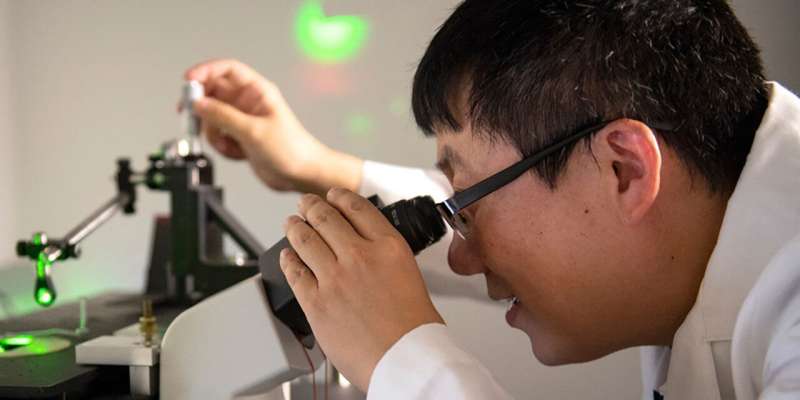This article has been reviewed according to Science X's editorial process and policies. Editors have highlighted the following attributes while ensuring the content's credibility:
fact-checked
trusted source
proofread
Researcher pioneers method of detecting early-stage cancer: Cheaper, faster, less invasive and accurate

Jiajie Diao, associate professor in the University of Cincinnati College of Medicine, has invented a method for detecting early-stage cancers that could help his colleagues at UC and worldwide save many lives.
It began with Diao's degree work at the University of Illinois and a postdoc at Stanford University. Diao remembers taking a coffee break and "chatting with the person next to me, and it turns out he was doing biomarker labeling. I was working on imaging, and I thought, 'Let's do something together.'"
The science that grew from that collaboration led first to an early pancreatic cancer detection procedure that received Food and Drug Administration breakthrough designation, then continued to grow at UC's Vontz Center for Molecular Studies, where Diao has perfected a new assay for diagnosing cancer and cancer progression that is cheaper than current procedures, faster, less invasive and, most importantly, more accurate.
"Ultra-sensitive detection methods are required for diagnosing early-stage cancers," Diao said. He describes his method, called single molecule epigenetic localization, as "a little like fishing." It uses a long strand of DNA to gather cell-free DNAs that are released by cancer cells and float free in a sample of blood (or urine, for kidney and bladder cancer), looking for DNA epigenetic modifications.
"These play important functions in a broad range of physiological and pathological processes," Diao explained. Their dysregulation can lead to a variety of human diseases.
Researchers then take a look at the epigenetic modifications of this dysregulated DNA—one type, called 5-hmC, has been recently linked to several types of cancer—by placing it on a microscope slide, then fluorescing and imaging it to learn not just how many cell-free DNA modifications exist, but where.
This is a dramatic advance, Diao said. "Current methods of epigenetic imaging are still blind to the specific genomic location of these modifications."
His invention, which he has successfully tested, "will provide additional insight to the diagnosing practitioner about where dysregulation exists, if cancer is the cause and whether that cancer has progressed." The new method offers remarkably high accuracy even in the earliest stages of cancer, Stages 1 and 2.
"That information is critical for early treatment," Diao said, "especially in the case of lung, pancreatic and other aggressive cancers."
Diao and his co-inventor, Chun-Xiao Song, associate professor at the University of Oxford, are collaborating with UC's Technology Transfer team. The duo have started the patent process and are now seeking partners to commercialize their technology. Those interested in further developing or licensing their assay should contact the tech transfer team.
















